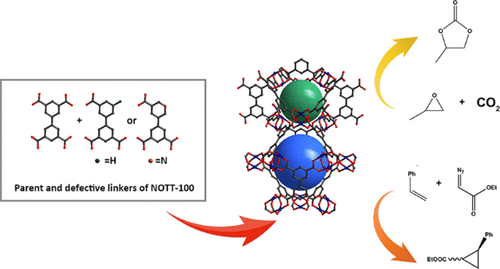Abstract of the full paper:
A series of new defect-engineered metal–organic frameworks (DEMOFs) were synthesized by framework doping with truncated linkers employing the mixed-linker approach. Two tritopic defective (truncated) linkers, biphenyl-3,3′,5-tricarboxylates (LH) lacking a ligating group and 5-(5-carboxypyridin-3-yl)isophthalates (LPy) bearing a weaker interacting ligator site, were integrated into the framework of Cu2(BPTC) (NOTT-100, BPTC = biphenyl-3,3′,5,5′-tetracarboxylates). Incorporating LH into the framework mainly generates missing metal node defects, thereby obtaining dangling COOH groups in the framework. However, introducing LPy forms more modified metal nodes featuring reduced and more accessible Cu sites. In comparison with the pristine NOTT-100, the defect-engineered NOTT-100 (DE-NOTT-100) samples show two unique features: (i) functional groups (the protonated carboxylate groups as the Brønsted acid sites or the pyridyl N atoms as the Lewis basic sites), which can act as second active sites, are incorporated into the MOF frameworks, and (ii) more modified paddlewheels, which provided extra coordinatively unsaturated sites, are generated. The cooperative functioning of the above characteristics enhances the catalytic performance of certain types of reactions. For a proof of concept, two exemplary reactions, namely, the cycloaddition of CO2 with propylene oxide to propylene carbonate and the cyclopropanation of styrene, were carried out to evaluate the catalytic activities of those DE-NOTT-100 materials depending on the defect structure.
